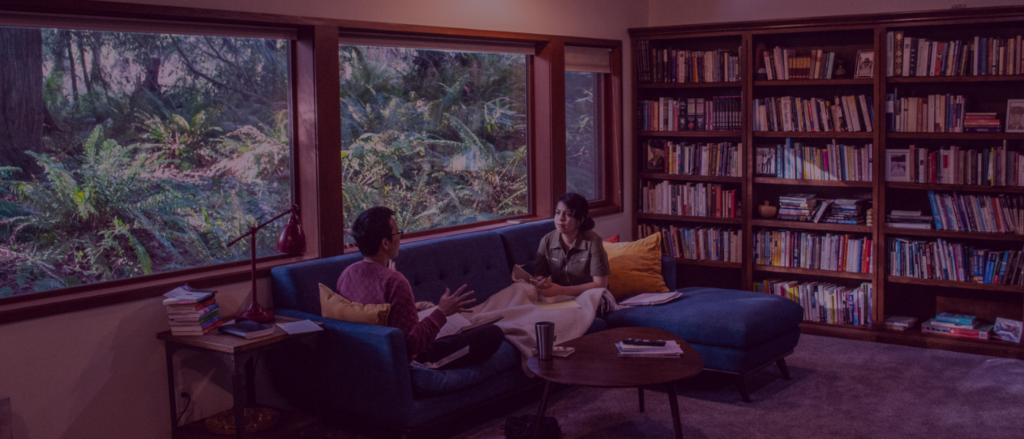At some point in time, you might find yourself Google’ing writing residencies. Perhaps you’re looking for time, space, or (faraway) place to work on your writing or finish a project. Maybe you’d like some mentorship, or to be in fellowship and community with other writers. Finding the right residency can feel difficult, especially at first: while some offer both time and space, some cost (a lot of) money, especially for emerging writers. In this resource, we share resources on how to know if and when a writing residency is for you, including our favorite kinds: digital and DIY ones.
To note: we focus primarily on writer residencies, as 1) we are primarily a literary publisher and 2) there are less resources specifically focused on writer and writing residencies (compared to art and artist residencies).
1. Where to begin.
Researching residencies can be overwhelming, especially when you see the slew of upcoming deadlines, which is why we’ve pulled together this resource, but it’s also why you should do some lowkey looking before you’re ready to apply. After all, applications for residencies happen the fall before the year you would attend.
- Lean into lists, like this Electric Literature roundup, which includes 20 free or low-cost American writing residencies, or this PNW-focused directory by Artist Trust, which also contains these three resource gems: Res Artis, TransArtists, and Artist Communities. There are some robust databases out there, like Poets & Writers, as well as annual lists, regional resource hubs, and even monthlies to keep tabs on, like Creative Capital’s roundups of residencies, grants, and award opportunities.
- Read first-person accounts of writing residencies, like “A Person of Color’s Guide to Navigating Writing Residencies” by Hannah Bae. Grab another coffee and watch this Author’s Guild panel on getting the most out of your experience (and then check out this accompanying spreadsheet that shares 45 low-cost or free residencies in the U.S), but also this LitHub piece on why residencies—and solitude—might not be for everyone. And check out this list of tips on applying to residencies. Each piece will fill in a gap you might not know you had.
- A good place to begin can be “place,” which you could do on Res Artist’s database by filtering for country, state, or region. You could also just Google it. For example, writing residencies in Florida. Using these filters can help tailor your search results based on your needs (for example, if you need to be closer to home) or your desires (to be as far away from work or rent as possible). You might also find some lists, like Aspiring Author’s, which geographically group residencies.
- Keep an eye out for residencies that curate space for writers like you. For example, Baldwin for the Arts in New York, created by Jacqueline Woodson, supports “the creation of art that reflects the lived experiences of African, Asian, Caribbean, Indigenous, Hispanic/ Latino/a/x, and dual-heritage backgrounds”; or Hedgebrook on Whidbey Island, run by Amber Flame, supports “women-identified writers (which is inclusive of transgender women and female-identified individuals) whose stories and ideas shape our culture now and for generations to come”; and Fire Island Artist Residency (FIAR) brings “lesbian, gay, bisexual, transgender, non-binary, intersex and queer identifying emerging visual artists to Fire Island—a place long-steeped in LGBTQ history—to create, commune, rest, reflect and contribute to the location’s rich artistic history.”
Start broad, get specific, and maybe even a little weird. Residencies can and have happened in all kinds of places, like on Amtrak (though not anymore), in a toll booth on a bridge (though it seems to be paused due to government funding), six weeks in the Smokies Mountains (though applications for 2025 are now closed), or in what was Ursula K LeGuin’s home. And, as always, don’t sleep on your local libraries. Walk into your local library and simply ask, “Do you have any resources for writing residencies?” While some actually have space reserved for writers and writing, like the Seattle Public Library, some residencies give you access to what you’re writing about, like New York Public Library.
2. Reasons to apply.
Three common appeals of a residency are time, space, and place.
- When it comes to “time,” many residencies are “self-guided” or “self-directed,” like the Banff Center for Arts & Creativity, which means your schedule—or your time—is largely up to you. But self-guided doesn’t (have to) equal alone. At Banff, for example, you’ll be there with a cohort, each cohort has a mentor that you can meet with 1 x 1, and people often eat at the dining hall or bistro. Or take Vermont Studio Center, where you’ll have your own private studio to work in, but with plenty of programming to opt into: presentations, craft talks, one-on-one manuscript consultations, individual studio visits, and even a Visiting Writer you could meet with. Or take Yaddo, which has quiet hours from 9am-4pm everyday, but communal dinners that residents are expected to attend each night. For some writers, this is a defining part of their experience: forming bonds with fellow residents. It’s not uncommon to walk away with new manuscript buddies, workshop besties, or an accountability group for years to come.
- When it comes to “space,” this can be physical, like accommodations (where you stay) and facilities (what you have access to). For example, accommodations can range from rooms to studios, lodges to cabins, bunkhouses to estates: at Centrum near Port Townsend, WA, where Copper Canyon Press was founded, residents get their own “rustic cabin”; at the Adirondack Center for Writing in upstate NY, residents stay in a “lakeside lodge”; at Hambridge in Georgia, the oldest program in the Southeast, residents get their own “secluded private studio and workplace”; or at Mineral School near Mt. Rainier in WA, residents live in an 800-square foot former classroom inside a school. Facilities can vary even more widely than accommodations, from studios to dining halls, galleries to swimming pools, and so on. When researching physical space, look for “Resident Resources,” scan for information on “facilities,” and see if there’s info on “lodging” in the FAQ section.
- Unsurprisingly, “place” is an inseparable piece, often shaping the experience of time and space. Who wouldn’t want to spend 1 month at Djerassi writing on a 538-acre ranch in the Santa Cruz mountains? Or two to six weeks at Tusen Takk living in an architectural wonder on an isolated peninsula near Lake Michigan? Or a month at Willapa Bay AiR living in a hamlet called Oysterland on a “finger of land embraced by three bodies of water”? And that’s just residencies based in the U.S. Take a look at this list of International residencies by Aspiring Author. Since every place has something unique to offer, some places might speak specifically to your work. For example, if you’re writing about a specific region, look for residencies in that area. Or if your work is specifically about nature, it can help to choose somewhere where you’d be immersed in big nature. These types of things are not only good for you and your work, but to mention in your cover letter, as to why that residency would benefit you and your work right now.
At the end of the day, all residencies will give you time away from things—the city of work, a role at home, to-do lists, or making decisions—and time for things: to listen to where your work is and where it wants to go. A residency will give you the space to spread out and walk aimlessly, look at the bigger and smaller pictures, to write or read all morning and night. And it will give you, and your work, a place to just be. To be unperceived. To breathe deep in big nature, or somewhere that makes your heart beat a bit slower.
3. On the matter of money.
When it comes to money and residencies, be on the lookout for financial aid, scholarships, stipends, fellowships, and application fees.
In short, scholarship is a type of financial aid where a residency/organization will offer an amount of money to a recipient in order to offset the cost to attend the program. Many residencies offer full or partial scholarships, which is huge, especially when a two-week residency can cost $3K. But some residencies don’t charge/cost anything to attend, like Storyknife; you’ll just need to pay for travel (and in Storyknife’s case, to and from Homer, Alaska). Some residencies offer stipends or honorariums while you’re there, like $300 in total at Jentel in Wyoming (but that’s because it doesn’t provide on-site food or dining) or an $850 weekly stipend at Loghaven in Knoxville, TN (not to mention a $200-500 travel subsidy and up to $200 reimbursement for materials). What’s up with Loghaven? They consider each resident a Fellow, and fellowships—like at Ragdale in Lake Forest, Illinois—are often awards that come with time, space, and money to work on your writing. And as you publish books, you can apply to “writers in residence” programs, where writers are paid to work on their writing at a residency, but sometimes with the requirement of giving lectures for the community or the expectation that they’re available for 1 x 1’s with paying residents.
The costs above are those you incur when attending a residency, but the first cost you might encounter is an application fee, which can range from $20-50. These fees can add up, so you may have to be discerning or specific when it comes to how many you apply to. We have a lot of thoughts about money in the arts, but that’s for a separate piece. Just know, it is a thorny part of the experience, as residencies are a business at the end of the day. Though many are non-profits that rely on grants, volunteerism, and fundraising to stay afloat, so while it can feel a certain way to have to pay for these experiences, it takes a lot of labor, love, and work to run them so that residents can have the experiences they do.
While you’re calculating costs, don’t forget that you could apply for individual artist grants from foundations for the explicit purpose of being able to attend an artist residency. For example, the Seattle City of Literature just launched a Microgrants program, which provides 4 x $750 stipends to artists pursuing projects with an international scope.
Don’t sleep on retreats, workshops, digital and DIY residencies
While we love a good residency—we’ve attended several of the ones mentioned above, not to mention we host our own—we’re big fans of DIY and digital ones, as well as workshops and retreats. Nothing replaces an in-person residency where you get to work for 2 weeks without interruption, but these other options can often be more accessible, they can be just as impactful (but in different ways), they can be a recurring part of your year, and they can be equal parts functional and intimate. In case you’re unfamiliar with them:
- A writing retreat is often communal in nature, bringing together a cohort of writers for a specific period of time. They can be as short as three days, or as long as 30. For example, Roots, Words, and Wounds, “a sacred space wherein BIPOC stories are celebrated”; The Watering Hole, “a home for poets of color in the South;” Kimbilio, ; or, check out the Iceland Writers Retreat (Yrsa Daley-Ward is a featured author for next year’s retreat).
- A workshop can be many things, but when said in the context of retreats and residencies, they are usually week-long, cohort-based programs—digital or in-person—where you’re working with a specific author of a specific genre. For example, you could check out Tin House Workshop Series in Portland, OR (note: they also have a residency program, too); Community of Writers near Lake Tahoe has two different weeklong workshops; and Clarion West have a range of workshops, from weekend to six-week summer ones; and Voices of our Nations Arts Foundation (VONA) have a variety of options, too.
- A writers/writing conference — and here, we’re not talking about the AWP’s of the world, but more intimate ones — are basically a writing retreat, residency, and workshop mashed up into one, as they often have cohorts of attendees, visiting mentors, workshop sessions, and more, like Sewanee in Tennessee, Breadloaf in Vermont, Key West Literary in Florida, or Aspen Summer Words in Colorado.
- Digital residencies have also emerged on the scene, taking the in-person format into a virtual experience that often spans several weeks or months. At Seventh Wave, we have a digital residency, Narrative Shifts, which is a seven-week, genre-agnost writing program that guides 2 x cohorts of 12-16 writers through seven sessions on specific topics of craft, story, and narrative. Digital residencies are often “intensives” or “immersive programs,” and can be a great precursor to an MFA program, or just a way to continue building community and momentum with your writing practice.
- When it comes to DIY retreats and residencies, there are plenty of ways to do it. For example, you could rent a house with a group of friends and have a schedule that everyone sticks to; book your own Postcard Cabin and unplug for 2-7 days; or, depending on where you live, you may also have access to places like Paragraph NY, which have their own kind of “residencies,” where they give you access to their writing rooms and desks, and so you could have a dedicated space to work on your writing that is in the city. You could also check out The Center for Fiction, which has workshops, but it also has similar awards and fellowships for access to their space. Note: you could also simply rent space at Paragraph or The Center for Fiction, if you have the resources to.
The journey of putting it together is yours.
In-person residencies will no doubt give you the time and space to work on your writing, but one of the things we cherish and covet most about any kind of residency is the opportunity to meet fellow writers and artists.
To be in actual community with others who are doing their work. The unscripted exchanges you’ll have while walking from your room to your studio, or the conversations you’ll strike up during breakfast or dinner, or over a glass of something at the end of a night. The book recommendations you’ll exchange, the advice you’ll share with each other, and the support you’ll feel in those lower or more lonely moments.
While it can help to know what you want to get out of a residency, there is also joy to be found in the unknown, so maintain a level of openness, especially if you haven’t been to a—or that—residency before. It’s hard to know just how much alone or social time there will be, and perhaps more importantly, how much of both you’ll really need.
The journey of putting it together is yours.
See more resources like these
For more resources like these, consider joining Well-Crafted, our paid writer’s hub, which have more detailed posts on things like writing voice-driven cover letters, when is the right time to apply to a residency, setting expectations for a two-week writing residencies, and even a 3-day schedule that you and your friends can follow for your DIY retreats.



